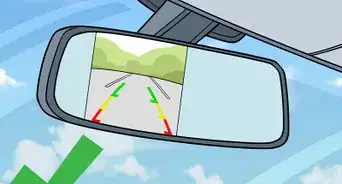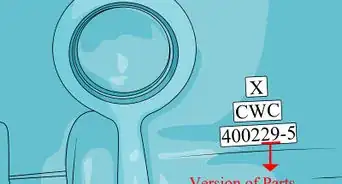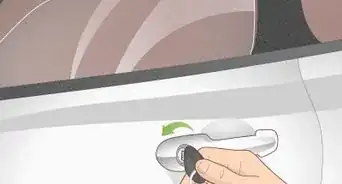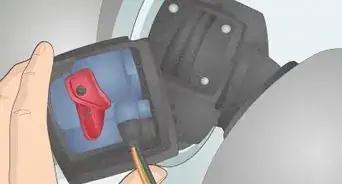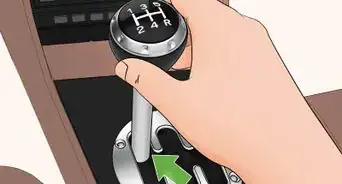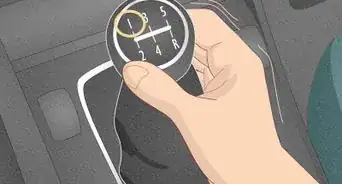wikiHow is a “wiki,” similar to Wikipedia, which means that many of our articles are co-written by multiple authors. To create this article, volunteer authors worked to edit and improve it over time.
wikiHow marks an article as reader-approved once it receives enough positive feedback. In this case, 94% of readers who voted found the article helpful, earning it our reader-approved status.
This article has been viewed 236,896 times.
Learn more...
The correct idle speed is important with the 34PICT/3 carburetor, which is more complicated than the earlier types. It has three separate fuel circuits in it.
Steps
-
1Ensure the engine is warm and the choke butterfly standing upright. Ensure the air cleaner is ON when adjusting the carburetor.[1]
-
2Locate the throttle arm on the left side of the carburetor.[2] It is controlled by the accelerator cable that runs to the accelerator pedal in the cabin.
- On the top of the throttle arm, facing to the rear of the car, is a screw called the Fast Idle Adjuster.
- This works with the choke to give a smooth idle on a cold engine.
- As the choke warms in concert with the warming engine, the butterfly valve in the throat of the carburetor opens and the Fast Idle Adjuster moves down the stepped cam, reducing the engine idle speed.
- Make sure that the choke is fully open and the Fast Idle Adjuster screw is resting on the very bottom of the stepped cam.
- Unscrew the Fast Idle Adjuster screw until it is clear of the stepped cam.
- Screw it in until it just touches the very bottom of the stepped cam -- NOT on any of the steps themselves.
- Now screw it in another 1/4 turn. This sets the throttle butterfly open the required 0.004 inch (0.0 cm).
Advertisement - On the top of the throttle arm, facing to the rear of the car, is a screw called the Fast Idle Adjuster.
-
3Locate the Volume Control Screw and the Bypass Screw on the left side of the carburetor. Turn the Bypass Screw (the larger one) out a couple of turns, to get things started.[3]
- The Volume Control Screw is the smaller of the two adjusting screws.
- Screw it in GENTLY until it bottoms.
- Now unscrew it exactly 2-1/2 turns.[4] This is the starting setting.
- Start the engine and use the Bypass Screw to set the idle at 850 rpm.
- The Volume Control Screw is the smaller of the two adjusting screws.
-
4Go back to the Volume Screw and adjust it (usually out -- counter-clockwise) slowly to obtain the fastest idle.[5]
- It should not be much outside the range of 2-3 turns 1/2 turn in/out from the basic 2-1/2 turn out setting.
- Turn the screw back IN very slowly until the revs drop by about 25-30 rpm.
-
5Use the Bypass screw again to reset the idle speed to 850 - 900rpm.[6]
- If you find it difficult or impossible to make these settings, it is possible that you could have stripped threads on any of these adjusters, a damaged hole for the tapered screw, or a damaged needle valve or O-ring.
- If you find it difficult or impossible to make these settings, it is also possible that you have a vacuum leak (i.e., leaking of air into the intake manifold).
Community Q&A
-
QuestionMy 1972 VW Bug will idle when cold, but not when warm. How do I fix this?
 Community AnswerI had the same issue. First, make sure you adjust carb after the engine is warmed up per the directions above. The "Volume Control" jet is usually the issue when it does not idle correctly. Make sure it is not more than 2.5-3 turns out, but less is better. If you hear any backfiring, even the slightest, the volume control jet is out too far and dumping too much fuel. Check the "O" ring on both "by-pass" and "Volume Control" jets. As you adjust out, the tightness should be consistent, otherwise the "O" ring is bad.
Community AnswerI had the same issue. First, make sure you adjust carb after the engine is warmed up per the directions above. The "Volume Control" jet is usually the issue when it does not idle correctly. Make sure it is not more than 2.5-3 turns out, but less is better. If you hear any backfiring, even the slightest, the volume control jet is out too far and dumping too much fuel. Check the "O" ring on both "by-pass" and "Volume Control" jets. As you adjust out, the tightness should be consistent, otherwise the "O" ring is bad. -
QuestionI have a 1971 VW Beetle. I have had it for 10 years and am starting to have issues with it. It struggles to pick up speed, and going up a hill is a no-go. I have changed the battery and air filter. What else should I do?
 Ginger BensonCommunity AnswerYou may want to check your hoses and connections for a vacuum leak. You'll lose power. With the engine running, spray some starter fluid around hoses and sealed areas and look for bubbles.
Ginger BensonCommunity AnswerYou may want to check your hoses and connections for a vacuum leak. You'll lose power. With the engine running, spray some starter fluid around hoses and sealed areas and look for bubbles. -
QuestionWhat do I do if I overhauled my carburetor and now my VW Beetle won't start?
 alejandroCommunity AnswerMake sure your accelerator pump is working, if there's an adjustment adjust it so you get a good strong stream coming out. Make sure you have power to your air bypass valve, and look for leaks at the intake gasket. You might even have your float set too low, make sure it is at the top of the bowl, usually one thin copper washer under float valve. Yes, you will probably have to take it off and apart, it's easier on a bench. Check volume screw (small one) is out about 2 1/2 turns and the big screw bypass screw about 1 1/2 turns. Put it back on. It could be a lot of things, as I didn't even mention the choke or vacuum leak. But make sure she squirts first and foremost. If you still can't find the problem, take it to a mechanic.
alejandroCommunity AnswerMake sure your accelerator pump is working, if there's an adjustment adjust it so you get a good strong stream coming out. Make sure you have power to your air bypass valve, and look for leaks at the intake gasket. You might even have your float set too low, make sure it is at the top of the bowl, usually one thin copper washer under float valve. Yes, you will probably have to take it off and apart, it's easier on a bench. Check volume screw (small one) is out about 2 1/2 turns and the big screw bypass screw about 1 1/2 turns. Put it back on. It could be a lot of things, as I didn't even mention the choke or vacuum leak. But make sure she squirts first and foremost. If you still can't find the problem, take it to a mechanic.
Warnings
- Common sense is a VERY IMPORTANT.⧼thumbs_response⧽
- Always use the proper tools for the job at hand.⧼thumbs_response⧽
- ABSOLUTELY NOTHING in this world is so important, that you should EVER practice unsafe maintenance on your vehicles.⧼thumbs_response⧽
- Safety should always be your #1 focus when working on a vehicle.[7]⧼thumbs_response⧽
Things You'll Need
- Tachometer
- Screwdrivers
References
- ↑ http://www.vw-resource.com/34pict3.html
- ↑ http://www.vw-resource.com/34pict3.html
- ↑ https://www.youtube.com/watch?v=qrsuZiVF-9s
- ↑ https://youtu.be/qrsuZiVF-9s?t=70
- ↑ http://www.vw-resource.com/34pict3.html
- ↑ http://www.vw-resource.com/34pict3.html
- ↑ https://www.dummies.com/home-garden/car-repair/auto-repair-safety-rules/
-Beetle-Step-1-Version-3.webp)
-Beetle-Step-2-Version-3.webp)
-Beetle-Step-3-Version-3.webp)
-Beetle-Step-4-Version-3.webp)
-Beetle-Step-5-Version-3.webp)
